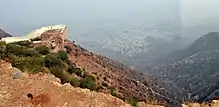 | |
| 26°26′32″N 74°37′06″E / 26.442154°N 74.618288°E | |
| Location | Ajmer, Rajasthan, India |
|---|---|
| Type | Fort |
| built by | Ajayaraja I |
Taragarh Fort is a fortress built upon a steep hillside in the city of Ajmer in the Indian state of Rajasthan. It was constructed in the 8th century by Ajayaraja Chauhan (721–734)[1] and it was originally called Ajaymeru Durg.[2]
History
This fort was known for its strength and strategic importance. First attack on this fort was made by Muhammad of Ghazni in 1024 AD. He laid down the siege, was wounded and failed to take the fort.[3]
Prithviraj, son of Rana Raimal of Mewar and elder brother of Rana Sanga, captured Taragarh fort of Ajmer during the end of 15th century, after slaying Governor Mallu Khan.[4][5][6] The fort is also called Taragarh, named after Prithviraj's wife Tarabai.[7] It remained under control of Mewar and later Rana Sanga granted it to Karamchand Panwar[8]
Architecture
There are three gateways to the fort known as Lakshmi Pol, Phuta Darwaza, and Gagudi ki Phatak. There were 14 bastions in the wall of this fort. Most parts of these gateways are now in ruins. The largest of its battlements is the 16th-century bastion known as the Bhim Burj, on which was once mounted a large cannon called Garbh Gunjam, or 'Thunder from the Womb'. In the fort are water reservoirs.
The fort also holds a shrine dedicated to Miran Saheb ki Dargah, who lost his life in 1202 CE during a Rajput attack. He was slain in a perfidious Rajput attack that took place while him and his men were conducting their prostration (namaaz).[9][10]
After conquering the fort of Kandahar, Emperor Jahangir built this Marble Cage (Kathera) in the dargah of Meera Syed Hussain in 1615.[11]
References
- ↑ Tomars of Delhi by Harihar Niwas Dwivedi. Gwalior: Vidya Mandir Publication. 1983. p. 175.
- ↑ Ajmer, Historical and Descriptive, pp. 50.
- ↑ Ajmer, Historical and Descriptive, pp. 50
- ↑ Dhoundiyal 1966, p. 54.
- ↑ Maharana Sanga The Hindupat, p28
- ↑ Ajmer:Historical and Descriptive, p45
- ↑ Rajawat 1991, p. 87.
- ↑ Dhoundiyal 1966, p. 55.
- ↑ Guides, Rough (3 October 2016). "Ajmer and around". The Rough Guide to India. ISBN 9780241295397.
- ↑ Asher, Catherine Ella Blanshard (1992). "The Age of Akbar". Architecture of Mughal India. Cambridge: Cambridge University Press. p. 79. ISBN 9780521267281.
- ↑ #Author:R. Nath, History of Mughal architecture, pp. 259
Further reading
- Crump, Vivien; Toh, Irene (1996). Rajasthan (hardback). London: Everyman Guides. p. 400. ISBN 1-85715-887-3.
- Michell, George, Martinelli, Antonio (2005). The Palaces of Rajasthan. London: Frances Lincoln. p. 271 pages. ISBN 978-0-7112-2505-3.
{{cite book}}: CS1 maint: multiple names: authors list (link) - Tillotson, G.H.R (1987). The Rajput Palaces - The Development of an Architectural Style (Hardback) (First ed.). New Haven and London: Yale University Press. p. 224 pages. ISBN 0-300-03738-4.
- Rajawat, D.S. (1991). Glimpses of Rajasthan: Off the Beaten Track. Delta Publications. Retrieved 7 April 2022.
- Dhoundiyal, B.N. (1966). Rajasthan District Gazetteers: Ajmer. Gazetteer of India. Ajmer. Hauptbd. Bharat Printers. Retrieved 7 April 2022.
- Sarda, Har Bilas (1918). Maharana Sanga, The Hindupat (1st ed.). Ajmer: Scottish Mission Industries Company Limited.
- architecture, mughal (1982). Ajmer Historical and Descriptive. Delhi: Abhinav, New Delhi, 1982-<2005>, Ajmer.ref=https://www.google.co.in/books/edition/History_of_Mughal_Architecture_The_trans/ha5fG13V3XcC?hl=en&gbpv=1&dq=khing+sawar&pg=PA259&printsec=frontcover